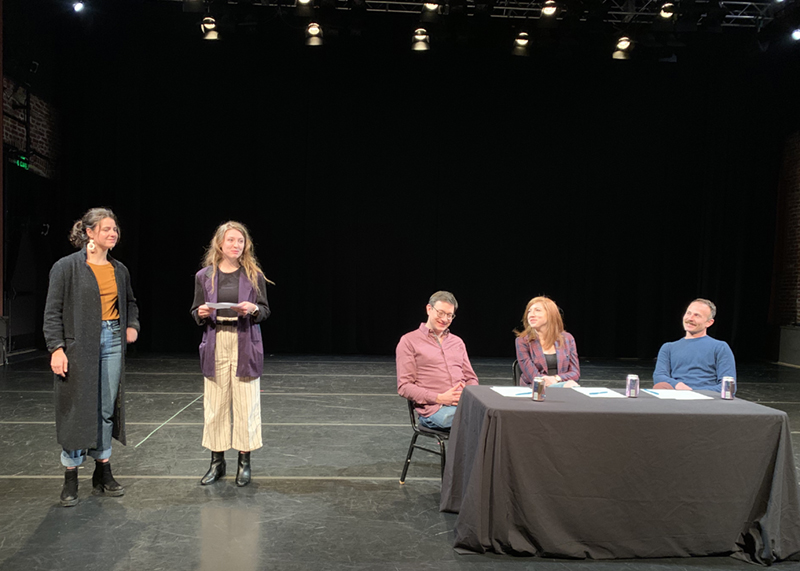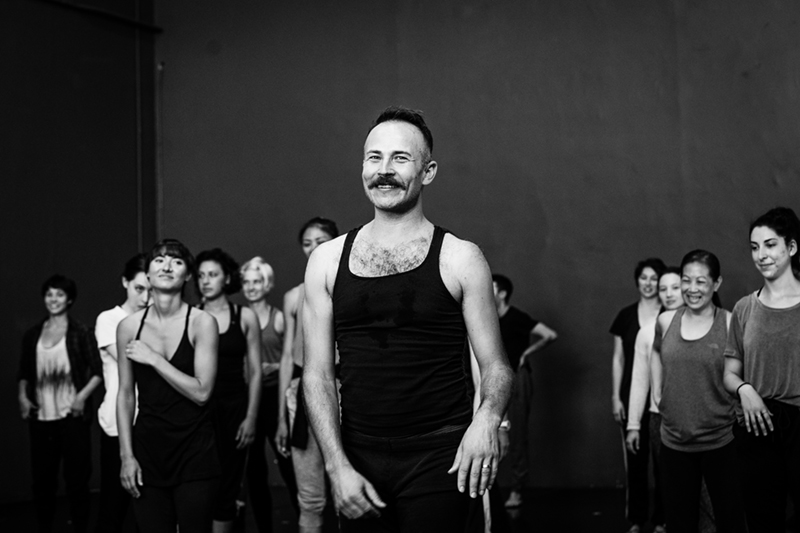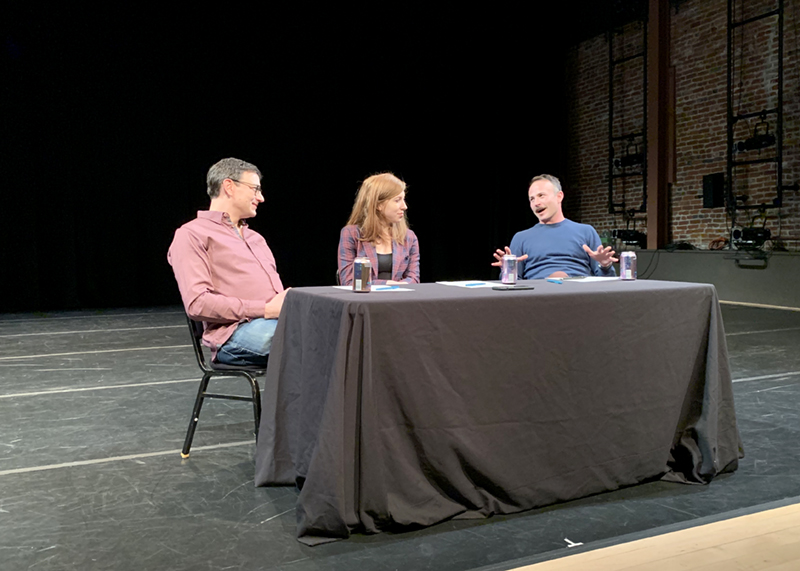On Labor and a Living Wage
Chlo & Co Dance is a Bay Area company comprised of Courtney King and Chloë Zimberg, whose most recent project, Tabled, brings together various artists to discuss endemic issues. The five-panel series runs from January through September at San Francisco’s ODC Theater (though is currently on hold due to the coronavirus). The first panel, Labor and a Living Wage: Creating a Viable Life in the Arts, was held on January 20th and featured Jessica Baldwin (assistant director of rentals events at the San Francisco Museum of Modern Art), Charles Slender-White (choreographer/artistic director of FACT/SF) and Matt Small (composer/artistic director of Small Art Music Projects).
Photo by Zachary Brill Newman
This transcribed and edited version seeks to continue the conversation. Please feel free to get in touch with emmaly@stanceondance.com or chlocodance@gmail.com with your own thoughts on labor and a living wage!
~~
Questions for panelists (given in advance):
- How has your relationship to accepting, rejecting or seeking work changed over time? What perspectives and values do you have now that you may not have had in the past?
- As an artistic professional, what standards do you have when making decisions about compensation? How does this choice relate to your values of time, experience, energy, effort, and artistry? How do these values affect you when you take the role of employer?
- How can financial viability be improved, achieved and maintained in the arts? What role and responsibilities do arts professionals, the arts community, and beyond have in this pursuit?
Charles Slender-White:
The first three years that I was running the company, we said yes to everything; every showcase in Sausalito, everything in San Mateo, every little performance. We were there full on; full company, full costumes, and we were just hemorrhaging money. The point was to build a track record, because I didn’t have one yet. Now, I find myself giving different advice like: “Follow projects you love and that pay you well or, if they don’t pay well, you should really love them, and if they do pay really well, then it doesn’t really matter if you love them too much.” That sort of thing. But, I personally feel like I’m able to pick and choose now because of that hustling at the beginning.
Jessica Baldwin:
My first job was doing audience development for a theater. When I got the offer, I thought, “I could survive on that. I’m not going to live off it, but I could survive off this.” The biggest mistake I made is I didn’t ask enough questions, like, “If we’re working late, can I get my taxes reimbursed? Are any of my meals covered? What’s the reimbursement policy for putting money on my credit card?” It turned out that, with this company, all those things were nonexistent, and I ended up going into debt for a job. The biggest thing I’ve learned is, when I get job opportunities, I try to ask the right questions about what the full financial situation will be. That’s made a big difference.
For example, this past fall I was working a production gig for Goop. The stipend was great, but I also asked about the per diem to make sure my transportation was covered. In negotiating, the biggest thing I’ve learned is being able to argue for a larger package and not just the stipend. I think about the full expenses.
Matt Small:
Going back to the artistic identity, there’s this balance between the commerce part and following your artistic vision. Develop what’s unique about you as an artist and then try to find where your work can fit. Don’t try to change: You’ve already developed what you do well. Find a way to make that work while still being flexible.
Charles:
Here’s a story: A colleague of mine had been scheduled to do a gig for a big, local tech company. Something came up for her and she couldn’t do it, so she offered it to me and another choreographer. I think this was a bit of a mistake; it effectively pitted me and the other choreographer against each other. We are friends and had been working together for a long time, but now we were fighting for this gig because in our minds it would be prestigious and there would be real money.
I talked with an executive who runs a PR firm and does a lot of contracts with tech companies. I asked what to pitch them. She wanted to know: “What’s the scope of the event? How many collaborators? What are they doing? What’s their budget?” In the end, she thought 10 grand was reasonable for a dress rehearsal, a show, me, three dancers, and some costumes. I said, “10 grand sounds great.” I get on the phone with the creative producer from the tech company and he asks me to pitch what I will do. I asked, “What’s your budget?” and he responded, “I would like to know what you’re going to ask for so that we can then assess if that works for us or not.” He held his cards super tight, and I felt like a piece of shit. I said, “I want 10 grand,” and then started negotiating against myself: “But it’s flexible.”
He ended up booking the other choreographer for three grand. She and I had not talked. I didn’t tell her what I asked because I knew she was going to undercut me. I thought she might ask for eight or 8.5 grand, but she said three and I was like, “Oh shit.” I felt like we got hosed. The tech company rented the Hibernia building downtown. This was not a $20,000 project, of which $3,000 was going to dance artists.
That was one experience I had that was crappy. One that was great was recently with Velocity Dance Center in Seattle. They run a building with three different spaces in it, and they booked me for this workshop. The artistic director and I agreed on dates and the fee. I would get paid $2,000 for five days of work, which is super. It’s $400 bucks a day.
Charles Slender-White, Photo by Robbie Sweeny
Jessica:
I oversee the rental program at SF MoMA, a key program for us because we use it as a relationship building tool by allowing companies and organizations to come in and use our space and experience it in a unique way. But it’s also an education opportunity. People look at our pricing for rentals and they balk and tell me there’s no way they’re going to pay that much. And then I have to tell them about our overhead. When you have millions of dollars of artwork, there’s some security that’s required. We also have staff that we pay a living wage. I educate them about the value they’re getting. I think that can happen on any level. Whether you’re an individual artist or a big organization like SF MoMA, it’s important to talk about the value of whatever the price tag is.
Matt:
I think the education happens on both sides. If you’re an artist in a situation where you don’t know exactly how all the details work, you get an education as you work through it and, sometimes, you’re the one educating people about how things are and how things should be. I had a trial by fire when dealing with the Giants and the Port of San Francisco. The contract was 400 pages, but I read the whole thing. When I asked them to sign off on two changes, they were like, “Sure, no problem, you’ve really gone through this.”
Charles:
Earlier in my career, I often felt like I was in an antagonistic relationship with presenters and funders. That they didn’t book me meant they had something against me. That was an operating ethos of mine for a while, which was of course unproductive. Then I realized that we are all allies working in the same direction. We might operate our ships in slightly different capacities and our boats might be different sizes, but we all want high quality work by an array of artists to be available to as many people as possible. But how we achieve that along the way matters quite a bit.
Matt:
It’s so hard to maintain a Zen professionalism where you make the person who’s rejecting you an ally of yours. That’s the most positive thing you can do when someone’s telling you no and you’re like, “Thank you so much for your time, I appreciate the feedback.” That goes back to this idea of building your bulletproof foundation, because there are always going to be situations you’re going to fit or not. But you can create your own solid base from which to work. You want to get to a place where it doesn’t matter.
Matt Small, Photo by Noah Berger
Jessica:
When I think about leadership positions in major arts institutions and the lack of diversity, I wonder what the barriers to entry are. Pay is often one. I was proud of SF MoMA last year; it was our first year paying interns, underwritten by Bank of America. It opened our pool of interns who otherwise may have had to take a summer job or were not in a place of financial privilege.
Audience question: There’s a lot of talk about transparency and equity. An idea I had with a colleague was to start an equivalent to an actor’s equity. Why don’t dancers have the same thing, to ensure health coverage and maybe a pension at the end of our careers? It’s a great idea, but what a nightmare that would be administratively, as well as the effect on people who are in leadership roles who might think: “I have to pay these people union wages? It’s hard enough paying people a stipend.”
Charles:
For the past five to six years, I’ve been talking with other organizations about having some sort of agreement on wages, working conditions, and a budget-to-compensation ratio. Do the dancers get a warm-up? Is someone leading the warm-up? Is there company class? Are they paid for that time? Do they get breaks? In the freelance community, these things don’t happen consistently. With an agreement on wages and working conditions, dancers could voluntarily adhere to a set of principles.
Jessica:
In America, we are not talking enough about the value of the creative economy and what we are genuinely contributing to the revival and importance of cities. With the way arts organizations are leaving San Francisco, we’re going to hit a crisis. No one wants to live in a city where there’s no art and culture. Gentrification happens in parts of town where art is vibrant. Restaurants pop up, hotel occupancy goes up. This whole economy grows from it. We need to be talking about the value we’re contributing. We have systems like Broadway, but we shouldn’t underestimate the value that even small arts organizations contribute to the local economy.
Jessica Baldwin, Photo by Jessica Baldwin
Audience question:
There’s a long history of dancers working as sex workers, like exotic dancing. That’s one of the ways we have historically made money from dancing and from our bodies in general. That’s also really complex because of legal issues, shame, and the devaluation of the body.
Charles:
A lot of the dancers I work with teach Pilates and fitness classes or they’re massage therapists. I’m not trying to draw an equivalence between being a massage therapist and being a sex worker, but both require knowledge of the body, empathy and touch.
Audience question:
Specifically, in the modern dance community, there’s a real question about equity. We commonly use “no one turned away for lack of funds” or a sliding scale. What are your thoughts on pricing and how to bring different types of audiences in?
Jessica:
Those are real questions. There’s been a lot of conversation about this in the museum world. Some local institutions are offering free memberships, and there hits a point where the question is asked, “By placing a zero price tag, are we saying it has no value?” It’s hard to try to create solutions that meet everyone’s needs. At SF MoMA, our adult ticket is $22, which I’ve heard people say is expensive. But, based on the number of visitors a year, we spend about $60 per visitor a year. The rest is subsidized through donations and grants to create that $22 ticket.
Under London Breed, the City of San Francisco created a program where, if you present your Medi-Cal or food stamp card, you get access to any museum free of charge. It’s not talked about a lot, but it exists. A press release went out, but I wonder how the program is being communicated to the actual communities that would use this?
There’s also been a lot of conversation about how we offer free days, as it’s a large expense to us. I have mixed feelings about it. We took a big sponsorship from Cruise, who make self-driving cars. They sponsored a bunch of our free days this past year, and all the sudden we were sticking a car in our lobby to market for them. I think there are ethical questions around that.
Charles:
I feel conflicted about this question. I think it’s ridiculous that we charge $20 for people to come see a show when that is what we charged when I moved here in 2008, in the middle of the recession. Everything has gotten more expensive, but when FACT/SF moved from $23 to $25 a ticket, there was a fair amount of pushback. This feedback is often from people who inevitably don’t offer to volunteer, don’t ask if there’s a “NOTAFLOF” policy, don’t ask if there’s a sliding-scale, and don’t ask if they can come to dress rehearsal, and, in the same breath, are advocating for higher dancer rates.
I don’t know that any of the modern dance venues in town would actually prevent someone from coming in to see a show. If you say, “I don’t have $20, but I have $10,” someone’s going to scoot you in. The ballet used to have a standing room for $20. I had a show with $40 tickets five years ago. It was inside a house and we only had 16 audience members at a time. Because it was an intimate audience, I was able to use the post show discussion to let everybody know that the per ticket cost was $268, and that their ticket was being subsidized to the tune of $228 per person by donors and funders.
Audience question:
There was a wonderful study that came out maybe 20 years ago on cultural tourism. Part of it looked at how you get someone to buy a ticket, and the study framed it in terms of risk: Do I know what the show’s going to be like before I go? Is it going to be good? Do I know where to park? Do I know how to get from the parking to the theater? Is there a good place to eat nearby? With contemporary work, it’s all about risk, and that’s why Nutcracker sells. People know what they’re getting.
Matt:
That’s an important thing to remember. There’s great cutting-edge stuff happening in the city, so we need to have that public conversation about the importance of supporting what’s new and vibrant, as well as the value of that. There’s a little bit of risk, but the payoff can be great.
Jessica:
In terms of Tabled, a future conversation might be the idea of cross-pollination. We all need to work together to survive. I think that’s a great subject to circle back to another time.
Photo by Courtney King
~~
To learn more, visit www.chlocodance.com/tabled.





